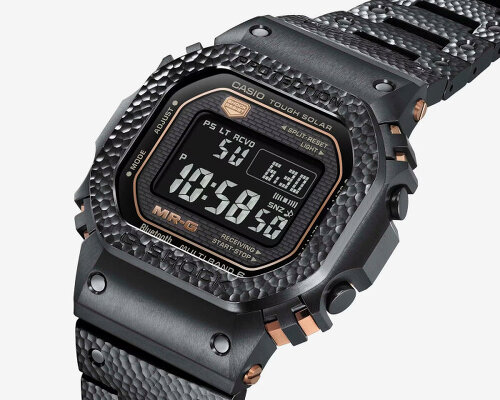Casio’s titanium MR-G watch features tsuiki technique
Casio releases MRG-B5000, an indented titanium watch under the MR-G series that uses the Japanese hammering technique named tsuiki. Considered a traditional craft practice in the country, the hammering technique, which literally translates to ‘shape with a hammer’, forms the bezel and bracelet of the timepiece design, individually and thoroughly hitting the surfaces to create the textures. The brand says that each unit is hand-hammered by Kazuya Watanabe, a trained tsuiki artisan from Sanjo City, Niigata Prefecture, so no two pieces are the same.
For the digital titanium-based watch, Casio uses the metal called DAT55G. It is a type of titanium alloy that is about three times harder than pure titanium, which makes the timepiece’s frame stronger and more resistant to damage. The outer surface of the design is finished with a diamond-like carbon coating to prevent scratches and wear, and as the wearer flips the accessory, they find that the rear is also made from titanium, closed tightly using a screw-lock system. In the middle of it lies the MR-G logo, engraved and pronounced, and because of the screw-lock system, the direction of the logo may not always align with the face of the watch, making the piece seem to be moving.
all images courtesy of Casio
design homage to the first G-SHOCK released in 1983
For the MRG-B5000 timepiece, artisan Kazuya Watanabe hammers 25 different parts, each of which is shaped and polished one at a time. The bezel has a multi-guard structure, which uses small cushions between metal parts, and these absorb shocks and protect the inner parts of the watch from impact. The overall shape of the titanium Casio MR-G watch follows the design of the first G-SHOCK, released in 1983. Even though it uses traditional handwork on the outside, the inside of the MRG-B5000 has modern technology, with a digital display and G-SHOCK’s usual shock resistance features. It also has advanced protection systems to handle strong impact or pressure.
The tsuiki technique has been used in Japan for a long time, often to make homeware and items like tea sets and metal ornaments. In the recent Casio MR-G watch made with titanium alloy, the tsuiki method is used on the outer metal parts. The pattern is created by changing the force and angle of hammer strikes, and the artistic approach is to create a pattern that does not look machine-made and does not repeat. The artisan uses a specific hammering method called yuragi, which means fluctuation, to produce natural-looking patterns with an organic texture.
Casio releases MRG-B5000, an indented titanium watch under the MR-G series
the timepiece design uses the Japanese hammering technique named tsuiki
the hammering technique, which literally translates to ‘shape with a hammer’, forms the bezel and bracelet
the brand says that each unit is hand-hammered by Kazuya Watanabe, a trained tsuiki artisan from Sanjo City
detailed view of the hammered bezel
the rear features the model’s engraved logo
the bezel has a multi-guard structure, which uses small cushions between metal parts
project info:
name: MRG-B5000
brand: Casio | @casiowatches_official
The post casio uses japanese hammering technique tsuiki to create indented titanium MR-G watch appeared first on designboom | architecture & design magazine.

